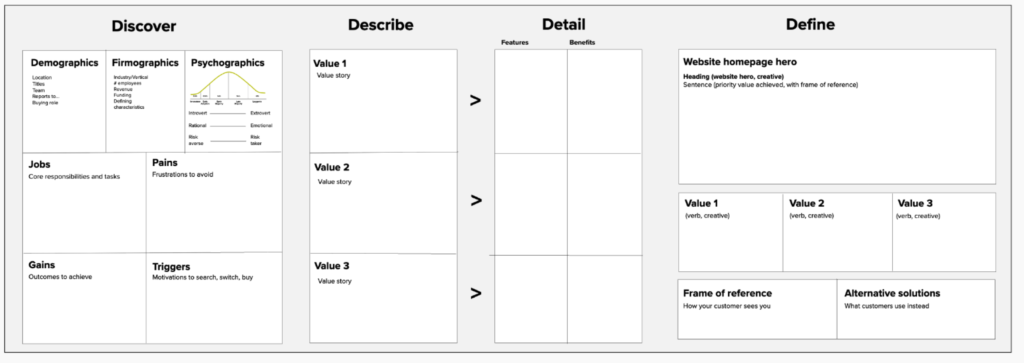Hi, I’m James. Thanks for checking out Building Momentum: a newsletter to help startup founders and marketers accelerate SaaS growth through product marketing.
Over the last 5 years, I’ve cultivated a positioning process that I call Customer Value Positioning.
I’ve written about all of the component pieces on this newsletter so regular readers will recognise the themes, but it’s taken me the last 12 months to revise, simplify, and improve based on the feedback of over 20+ marketers.
With Customer Value Positioning (CVP), you’ll:
- Define the perfect website heading and slogan that resonates
- Detail exactly how your product helps your customer achieve their goals
- Describe the top three outcomes your customers desire
- Discover your ideal customer profile and build a fluff-free persona that aligns your sales, marketing, and product teams
And, just like the name might suggest, we’re basing the whole process on the only thing that matters: your customer.
In this post:
Background: Why positioning needs more support
Last year I was named Positioning & Messaging Maestro of the Year 2021 by the Product Marketing Alliance.
Positioning is my jam: the intersection of customer-centricity, internal assumptions, and strategy in practice.
The literal definition of positioning is “to occupy a space in the customer’s mind,”… but how are we going to position effectively if we don’t understand what’s going on in their head?
Traditionally, marketers have relied on the ol’ trusty positioning statement, something that’s been around for ~30+ years. Unfortunately, it’s become a limp safety blanket for uninventive marketers and founders, crushing their innovations and aspirations into a maddening game of adlibs.
More recent positioning frameworks like Obviously Awesome have provided a much-needed boost and spotlight on positioning as a whole… but after talking to 100+ product marketers and founders over the last few years, it still leaves a gap:
- Positioning has so many subtle inputs, and is too intangible for many “casual” users to internalise no matter how good the book is
- Trying to connect the dots between the product you’ve built and the customers you think are good fit is difficult, because we’re so close to it that we can’t see the wood for the trees
- Usually these processes don’t have a tangible output – a mark of success that helps build momentum. A positioning document is great: but then what? How is that doc then translated to the website, or a tradeshow banner, or a sales deck?
Download The Customer Value Positioning framework

(If you really don’t want to sign up, you can find the PDF here).
Introducing my battle-tested positioning process
Firstly, I want to mention that this framework builds on top of the work of many great marketers, and as such you’ll see echoes and similarities with the work of April Dunford, Myk Pono, Al Ries and Jack Trout, Andy Raskin, and more. If this framework can be a quarter as good as their work, I’ll be happy.
Secondly, customer value positioning is not strictly just a framework, it’s a battle-tested process.
It’s built to ensure that with the right inputs and the right questions asked, the outcome is the same: quality positioning that resonates with your customer, and showcases how your product supports them in obtaining the value they desire.
Let’s walk through the process.
Discover your buyer persona
Buyer personas are discovered, not created.
The most valuable input to this process is customer insight. You can use your internal assumptions, but please: go and ask 10-15 customers these questions.
Transcribe your interviews, extract each point into an online Mural board, then group and summarise the themes.
Then organize those themes into:
- Jobs: common responsibilities and activities your customer does as part of their day-to-day
- Gains: their personal, professional, or business goals they want to achieve
- Pains: marks of failure and frustrations the customer must avoid
- Triggers: motivations that encourage them to solve their problem and switch away from their current solution
Make sure you’re also capturing some information on your customer’s psychographic profile. Are they early adopters and innovators, or laggards? Are they rational or emotional beings? Introverts or extroverts?
Describe the value your customers desire
I define value as an element that your customer wants to attain that:
- Is useful
- Is worth the effort (cost, time, energy)
- Is a priority for them
These might be the outcomes of solving problems and overcoming challenges, or new states that they can achieve by unlocking new capabilities.
You’ll see value themes jump out at you from the previous step. Describe why the value is important to the customer, with a value story following this script:
- Situation:
- Today, our customer is… (what are they doing, what’s the situation that sets context for the value?)
- Problem:
- However, …(the limitations or challenges that they’re experiencing)
- Implication:
- This means…(what’s the downside of continuing in the current way?)
- Resolution:
- By… (what does fixing the problem look like, not necessarily your product)
- Value:
- … our customer will…(detail the value they can gain)
Detail how your product helps
We can’t promise that we’ll help customers achieve their outcomes without connecting it back to our product.
Think about the features within your product that support each desired value. These might be an obvious product capability like an integration, a less obvious consideration like a modern and clean UX, or even service elements like a dedicated account manager
Then list out the benefits that those features enable. Benefits are tangible advantages a buyer experiences when using your product; something they can report on, and usually starts with a verb.
Define your positioning
Start at the bottom.
Frame of reference
April Dunford’s book explains how a frame of reference works with a great example. A wholegrain cake can be a diet muffin, or a paleo snack – depending on the target customer.
The frame of reference, or category, you define your product as will help target customers understand in a few words what you are, what you do, and whether they’re interested or not.
Think about the value your customer desires, the trends they’re experiencing in the market, and how they interpret your product.
Alternative solutions
Your biggest competitors are probably spreadsheets and people power, rather than technology vendors. Defining the alternative solutions that your customers actually use will help your frontline sales and marketing teams to consider how they frame your product in conversations and in marketing material, and provides a foundation to build shared understanding.
Are customers relatively green and new to the market, using niche cloud solutions? That requires different go-to-market tactics, compared to customers who use legacy enterprise hosted solutions.
Value statements
For each value story you created in the Describe stage, get creative.
Think about how you message and wordsmith the outcomes they seek. Start these with a verb: get, make, change, smash, unlock, break, bring, grow – the opportunities are endless.
Website homepage hero
I think the most obvious use of positioning is to decide what you say on the top of your website homepage, so it makes sense to just lock this down in the positioning process.
You’re going to write two things:
- A creative heading that catches attention and appeals to the outcomes your customer desires
- A matter-of-fact sentence that describes what your product is (frame of reference), and key values or benefits
You can find some examples of good homepage messaging here.
Remember the psychographic details you captured in the first stage? Use these to find your tone of voice. If your customer is an innovative extrovert, you have license to be more creative and wacky; if they’re more risk-averse and logical, you’ll need to focus on the facts more than feelings.
Four steps to focused customer value positioning
In four stages, you’ve:
- Discovered your ICP and built a fluff-free persona that aligns your sales, marketing, and product teams
- Described the top three outcomes your customers desire
- Detailed exactly how your product helps your customer achieve their goals
- Defined the perfect website heading and slogan that resonates
And this process works, regardless of your industry, target customer, or product.
This process always results in successful positioning.
Think back to the definition of positioning: “to occupy a space in the customer’s mind,”.
Following the Customer Value Positioning framework helps you position more effectively by understanding exactly what your customers care about, finding the gaps that exist, and occupying them with positioning that resonates.
Frequently asked questions
Who should be involved in this process?
I recommend the CEO, a marketing lead, a sales lead, and a product lead: people who have experience with customers, and are charged with directing teams to make change. Positioning often leads to new ideas: don’t waste that opportunity.
What customers should we talk to?
Your ‘best-fit’ customers (and non-customers like them): those that represent the best product/market fit, the best growth opportunity, the highest satisfaction with your product. Niche down for tighter results.
How long does this take?
Most teams will budget for a minimum of 4 weeks with ~4 hours of workshops a week, but often 6-8 weeks gives you the opportunity to set customer interviews, interpret findings, and validate your messaging with internal teams and external methods.
Do we have to do research interviews?
Yes. I feel extremely strongly that interviewing best-fit customers, prospects, and friendly people in the market is the best way to understand your customers. You can do this process by building on top of internal assumptions, but it will never be as strong. Focus on evidence over assumptions.
Can you help facilitate this process, or recommend others who can help?
Yes – book an intro call here.
Thanks for reading! Let me know what you thought – find me on Twitter and LinkedIn.
P.S. If you’ve found value in Building Momentum, could you buy me a coffee? Here’s my tip jar – any support is gratefully appreciated!
P.P.S: If you enjoyed this post, will you share Building Momentum with your network?




